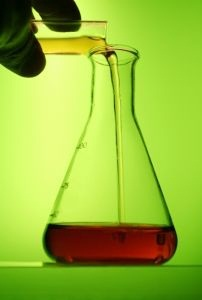Question:
How to prepare biological buffers?
The Protein Man Says:
Buffers are essential to life. They help maintain the proper functioning of cellular systems by resisting rapid changes in pH. In living organisms, the pH of the blood is maintained at a pH of 7.4. A slightly more basic pH (7.7) would result in convulsions and muscle spasms while a slightly acidic pH (6.95) would result in coma and even death.
 Most chemical reactions are affected by the acidity of the solution in which they occur. As such, you can maintain a constant concentration of hydrogen ions within the physiological range, manipulate a particular reaction to occur or to proceed at an appropriate rate by controlling the pH of the reaction medium through the use of the appropriate biological buffer system.
Most chemical reactions are affected by the acidity of the solution in which they occur. As such, you can maintain a constant concentration of hydrogen ions within the physiological range, manipulate a particular reaction to occur or to proceed at an appropriate rate by controlling the pH of the reaction medium through the use of the appropriate biological buffer system.
Biological Buffers: Reviewing the Basics
Basically, buffers are molecules that donate or accept protons to resist changes in pH as acids or bases are added to the solution. A buffer consists of a weak acid and its conjugate base, or a weak base and its conjugate acid. The dissociation of a simple acid HA can be described by the following chemical reaction:
HA ---> H+ + A-
Upon the addition of a strong base such as NaOH to the buffer solution, the hydrogen ion will bind with the hydroxide ion to form water. Upon the addition of a strong acid, however, the conjugate base will simply bind with the additional hydrogen ions to form acetic acid. In each case, equilibrium can be maintained.
Note: Weak acids and bases do not dissociate completely in water but exist in solution as a mixture of dissociated and dissociated molecules.
How Do Buffers Work?
All buffers have an optimal pH range over which they can moderate the changes in hydrogen ion concentration. This is generally defined as the pKa or the negative log of the dissociation constant of the acid. The pKa can be determined by using the Henderson-Hasselbalch equation:
pH = pKa + log10 [A-]/[HA]
However, since there are acids that can lose more than one hydrogen ion (polyprotic acids), they can have multiple pKa values. If the pKa values are close together, the optimal pH range will be a continuum determined by the range of pKas.
General Criteria for Biological Buffers
Buffers for biological systems should satisfy the following requirements:
-
A pKa between 6.0 and 8.0
-
High water solubility and minimal organic solvent solubility
-
Exclusion by cellular membranes
-
Minimal salt interactions
-
Minimal interactions between buffer and critical reaction components
-
Should not absorb light in the visible or UV spectrum
-
Stable and resistant to enzymatic degradation
-
Minimal changes on dissociation from changes in concentration and temperature
-
Easy to manufacture and purify
-
Cost-effective
Some Biological Buffers and How to Prepare Them
Citrate Buffer (pH Range = 3.0 to 6.2)
Mix 0.1M citric acid and 0.1M sodium citrate in the proportions indicated below and adjust the final volume to 100 ml using deionized water. You can then adjust the final pH using a sensitive pH meter.
|
Citric acid (in ml) |
Sodium citrate ( in ml) |
pH |
|
46.5 |
3.5 |
3.0 |
|
35.0 |
15.0 |
3.8 |
|
20.5 |
29.5 |
5.0 |
|
7.2 |
42.8 |
6.2 |
Acetate Buffer (pH Range = 3.6 to 5.6)
Mix 0.1M acetic acid and 0.1M sodium acetate in the proportions indicated below and adjust the final volume to 100 ml using deionized water. You can then adjust the final pH using a sensitive pH meter.
|
Acetic acid (in ml) |
Sodium acetate ( in ml) |
pH |
|
46.3 |
3.7 |
3.6 |
|
30.5 |
19.5 |
4.4 |
|
14.8 |
35.2 |
5.0 |
|
4.8 |
45.2 |
5.6 |
Phosphate Buffer (pH Range = 5.8 to 8.0)
Mix 0.1M sodium phosphate monobasic and 0.1M sodium phosphate dibasic solutions in the proportions indicated below and adjust the final volume to 200 ml using deionized water. You can then adjust the final pH using a sensitive pH meter.
|
Sodium phosphate, monobasic(in ml) |
Sodium phosphate, dibasic( in ml) |
pH |
|
92.0 |
8.0 |
5.8 |
|
73.5 |
26.5 |
6.4 |
|
39.0 |
61.0 |
7.0 |
|
5.3 |
94.7 |
8.0 |






